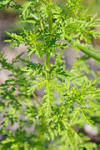

_small.jpg)
WILD FOODIES' HOME PAGE
PLANT PROFILE LIST
NAME: SWEET ANNIE
SPECIES / FAMILY: Artemisia Annua / Asteraceae or Compositae
COMMON NAME(S): Qing Hao, Sweet sagewort, sweet wormwood
CONDITIONS: sun, farm fields, urban areas
|
PARTS: |
EDIBLE |
TASTE |
RAW/COOK |
SEASON |
|
All |
|
|
|
|
|
Shoots |
|
|||
|
Leaves |
|
sweet sage |
steep as tea |
summer |
|
Buds/Flowers |
|
|
|
|
|
Fruits |
|
|
|
|
|
Roots |
||||
|
Seeds |
|
|||
|
Nuts |
|
|
|
|
|
Pods |
|
|
|
|
|
Stalk |
|
|
|
|
|
Bark |
|
|
|
|
PORTION: small, herb
COMMENT: This is an amazingly sweet smelling plant! It also has a wide range of health benefits and reportedly can be drunk daily as a tea.
CAUTION: Skin contact with the plant can cause dermatitis or other allergic reactions in some people. The pollen is extremely allergenic.(1)
NUTRITION/MEDICINAL: Qing Ho, better known in the West as sweet wormwood, is a traditional Chinese herbal medicine. An aromatic anti-bacterial plant, recent research has shown that it destroys malarial parasites, lowers fevers and checks bleeding[238, 254, 279]. It is often used in the Tropics as an affordable and effective anti-malarial[254]. The leaves are antiperiodic, antiseptic, digestive, febrifuge[176, 178]. An infusion of the leaves is used internally to treat fevers, colds, diarrhoea etc[222, 254]. Externally, the leaves are poulticed onto nose bleeds, boils and abscesses[222, 238]. The leaves are harvested in the summer, before the plant comes into flower, and are dried for later use[254]. The plant contains artemisinin, this substance has proved to be a dramatically effective anti-malarial against multi-drug resistant Plasmodium spp[218, 238, 254, 269]. Clinical trials have shown it to be 90% effective and more successful than standard drugs[254]. In a trial of 2000 patients, all were cured of the disease[218]. The seeds are used in the treatment of flatulence, indigestion and night sweats[222].(1)
Look-A-Like & Related: Ragweed
POISONOUS LOOK-A-LIKES:
OTHER USES: Essential Herbicide Miscellany Agroforestry uses: Artemisia species are often used for soil improvement, as ground cover, and in companion planting due to their pest-repellent properties. Some species are also used for erosion control. The plant is used in China as a medium for growing Aspergillus which is used in brewing wine. The substances mentioned above in the medicinal uses, used in the treatment of malaria, also show marked herbicidal activity[222]. The plant yields 0.3% essential oil[240]. This has an agreeable, refreshing and slightly balsamic odour and has been used in perfumery[240]. 1. Nectary - Flowers rich in nectar and pollen: Yes – Artemisia species produce flowers that can provide nectar and pollen, attracting various pollinators, including bees. 2. Wildlife - Food (Fruit, Seeds, Leaf litter, Shelter, Nesting, Roosting): Yes – The leaves of some Artemisia species are consumed by various insects and herbivores. Additionally, the plant can provide cover for small wildlife. 3. Invertebrate Shelter (Overwintering sites, Leaf litter, Groundcover): Yes – The dense foliage can offer shelter and overwintering sites for beneficial insects, and the leaf litter can provide habitat for various invertebrates. 4. Pest Confuser (Smell): Yes – Many Artemisia species are aromatic and can confuse or repel pests due to their strong scent, which may deter some insects. https://pfaf.org/user/Plant.aspx?LatinName=Artemisia+annua
SOURCE LINKS (may include nutritional and medicinal info, plus other uses):
COMPARISON OF DIFFERENT SPECIES OF ARTEMISIA:

https://www.sciencedirect.com/topics/agricultural-and-biological-sciences/artemisia-genus
Fig. 1. Leaves and synflorescences of four Artemisia species. (A) Artemisia absinthium. (B) Artemisia annua (Sweet Annie). (C) Artemisia dracunculus (French Tarragon). (D) (Mugwort) Artemisia vulgaris. For each species, the leaves placed in the upper or left side show the adaxial face and those placed in the lower or right side show the abaxial face. Photographs by P. Barnola, A. Mallol and L. Vilar (synflorescences of A. absinthium—detail—and A. dracunculus), G. Pié (synflorescence of A. annua) and J. Vallès (the rest).